Brown Bugs on Plants (Including Tiny Bugs) – Pictures, Identification and Control
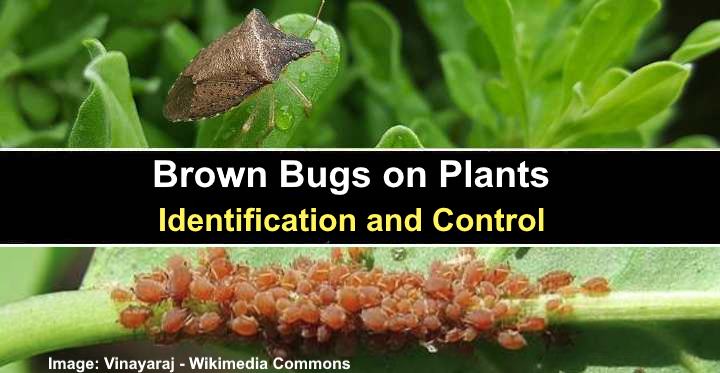
Brown bugs on plants are significant pests on ornamental shrubs, flowering plants, houseplants, and crops. Small, destructive brown bugs like aphids, spider mites, Asiatic beetles, and Colorado potato beetles can devastate decorative plants and crops. The tiny brown bugs bite into plant tissue and suck juices or burrow in the ground and consume roots.
Identifying brown bugs on plants can be challenging. For example, brown aphids and thrips are tiny plant-destroying creatures that lurk on the underside of leaves and are difficult to spot. However, brown soft scale insects look like brown bumps on a plant. Some brown pests are only identified when they cause considerable damage to plant foliage.
Knowing how to get rid of small brown bugs for good requires identifying the type of crawling or flying pest causing damage. In addition, preventing infestations of tiny brown bugs involves ensuring excellent plant health and nutrition. In many cases, a multi-faceted approach is vital to eradicate pesky brown bugs from your front or backyard plants.
This article is a guide to the most common brown bugs you’ll likely find in your yard. Descriptions and pictures of the creatures will help identify them. And you will get handy tips on how to kill the brown pests for good.
Brown Bugs vs. Brown Insects
Most people refer to any type of brown plant pest as a bug. However, all brown bugs are a small group of insects in the order Hemiptera. Therefore, not all insects are bugs in the scientific sense. True bugs are sap-sucking insects with piercing mouthparts and rarely have wings. But, not all insects destroy plants by sucking their sap.
The article refers to all kinds of brown pests—true bugs or otherwise—as bugs. This is because bugs are often referred to as any type of annoying creature that harms or infests plants.
Types of Brown Bugs on Plants (Overview)
Tiny brown plant bugs in the order Hemiptera are typically aphids, brown citrus aphids, brown soft scale, and brown marmorated stink bugs. These true bugs bite into plant tissue with piercing mouthparts to suck plant juice. Unfortunately, the bug’s biting action can also transmit diseases that weaken plant growth.
The types of brown insects that are not scientifically classed as bugs are spider mites, thrips, and various species of garden beetles. These annoying brown pests cause damage by feeding on plant leaves or destroying seedlings.
How to Identify Small Brown Bugs on Plants
Tiny brown plant bugs can be challenging to identify. They are usually too small to notice their characteristic features. However, you may notice groups of brown bugs like aphids, spider mites, or thrips on the underside of leaves. Or you could notice evidence of plant damage—wilting or yellowing leaves, galls, or holes in leaves.
Have you noticed brown bumps under leaves or on shrub stems? If so, these bump-like growths could be soft scale insects that attach themselves to parts of plants to suck their sap.
Signs of Small Brown Bugs on Plants
The most common signs of a brown bug infestation on plants are foliage damage and stunted growth. The obvious sign of bug damage is leaves riddled with holes. But plant-destroying insects bite into stems, petioles, and roots to feed on sap. This way, the bugs also spread bacteria and viruses.
Common signs of plant damage are sticky, amber-colored honeydew, discolored or curled leaves, and wilting growth. Another sign of brown bugs on plants is increased ant activity in the garden. The sweet-tasting honeydew attracts ants that feed on the substance.
Related reading: Ants in the garden – good or bad?
Tiny Brown Bugs on Plants
The tiniest brown bugs on plants are typically thrips or aphids. These tiny insects can measure as little as 0.019” (0.5 mm) and look like tiny brown-black dots on plant leaves. Aphids are also tiny brown bugs, but not as small as thrips. The brown insects look like tiny seeds measuring 0.039” to 0.27” (1 – 7 mm) long.
How to Get Rid of Brown Bugs on Plants
Several natural methods to rid plants of brown bugs are neem oil, insecticidal soap, and rubbing alcohol. For brown flying bugs, you can reduce their numbers by using blue or yellow sticky traps. However, it is tricky to eradicate brown bugs from plants because they can be hard to spot.
To get rid of brown bugs completely, using a combination of several plant-controlling techniques over a period of time is vital.
For example, you could spray neem oil once a week to disrupt the bugs’ life cycle. Then dab rubbing alcohol on small brown bugs you spot. And lastly, taking the garden hose to blast shrubs can dislodge hundreds of nasty brown bugs from plant leaves.
Types of Small Brown Bugs on Plants (With Pictures and Identification)
If you’ve encountered small brown dots or specks on garden plant leaves, knowing how to identify them is the first step in eradicating them. Please read on to find out how to solve the problems of brown bugs on plants.
Brown Soft Scale (Coccus hesperidum)
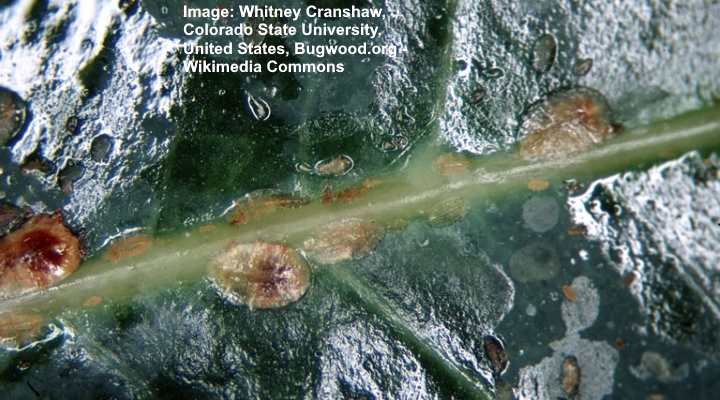
Brown soft scale insects look like small rounded growths on the plant under leaves and stems
Brown soft scale is a bug that looks like bumpy growths on woody plant stems or the underside of leaves. Brown scale bugs have an oval, dome-shaped body and can measure 0.12” to 20” (3 – 5 mm) long. The yellowish-brown bug is covered in dark brown spots, and the bugs bite plant leaves to suck their juice.
Brown soft scale damage usually manifests as weak or stunted growth in plants. In addition, as the brown scale insects feed, they excrete sweet honeydew—a sticky substance that causes black sooty mold.
Small Brown Bug Identification: Brown soft scale is identified as brownish rounded growths on plant leaves and stems. Typically, the presence of honeydew is an excellent way to detect brown scale insects on plants.
How to get rid of brown soft scale
The best way to eliminate brown soft scale bugs from plants is to use a cotton bud dipped in 70% alcohol. Then, dab each small brown bump under leaves or on stems to kill scale insects instantly.
Brown Aphids (Aphiodoidea spp.)
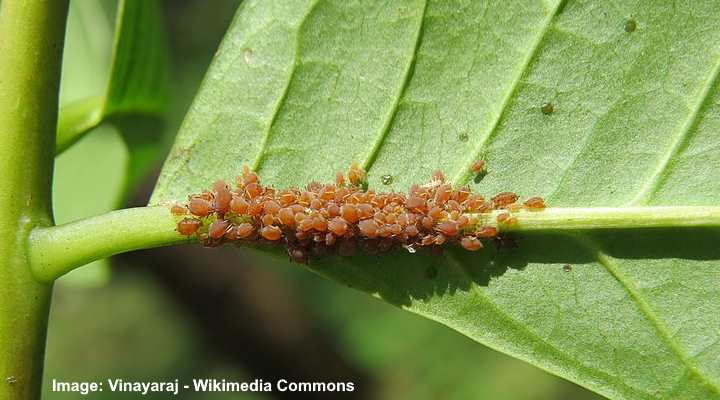
Brown aphids are tiny pests that can cause plant damage if there is a large infestation
Brown aphids look like tiny brownish sesame seeds stuck to the underside of plant leaves. These common brown garden pests grow 0.07” to 0.15” (2 – 4 mm) long. Identifying features of aphids are their pear shape and two cornicles (black tubes) at their tail end. Aphids can be brown, gray, black, yellow, or red.
Brown aphid damage on plants happens when an infestation is severe. Aphid-infested plants have yellowed, curled leaves, stunted stems, and poor plant growth. In addition, you may notice honeydew on plant foliage.
Small Brown Bug Identification: Brown aphids are tiny pear-shaped insects with six legs, two antennae, and two cornicles at their posterior.
How to get rid of brown aphids
The first step to getting rid of an infestation of brown aphids is to use short, sharp blasts of water to dislodge the pesky insects.
You can use a neem oil spray to kill brown aphids on ornamental shrubs or plants. You should mix 2 tsp. neem oil with 1. tsp. liquid Castile soap and dilute with 1 quart (1 l) of water in a spray bottle. Spray the affected plants, ensuring both sides of the leaves are covered entirely. Repeat once a week until the aphids are gone.
Brown Citrus Aphids (Toxoptera citricida)
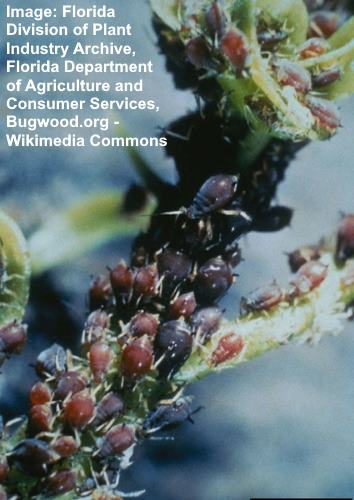
Brown citrus aphids (Toxoptera citricida)
The brown citrus aphid is a dark-colored bug with a brown to black pear-shaped body and whitish legs. The tiny dark reddish-brown bugs measure 0.059” to 0.11” (1.5 – 2.8 mm) long. Brown citrus aphids are a significant pest to orange and lemon trees in Florida.
Thrips (Thysanoptera)

Thrips (Thysanoptera)
Thrips are minuscule slender brown or black insects typically measuring less than 0.039” (1 mm). Plant leaves infested with trips will appear covered in pepper-like black specks. Pictures of the brown bugs show they have a slender, bullet-shaped body, crooked legs, and two antennae.
Because brown thrips are so tiny, you typically can only identify them by the damage they do to plants. Even under a magnifying lens, the insects look like tiny brown dots on leaves.
Thrip damage on plants looks like small white or brown patches on leaves. A significant infestation could result in plants with stunted growth that produce damaged fruit or flowers.
Small Brown Bug Identification: Thrips are hard to identify with the naked eye because they look like tiny dark specks on leaves.
How to get rid of thrips
First, remove and destroy heavily infected foliage and stems to eradicate thrips from your prized garden plants. Next, use hard blasts of water to get the bugs off the other leaves. Lastly, use a natural insecticidal soap to treat plant foliage and kill the annoying bugs for good.
Brown Spider Mites (Tetranychidae)
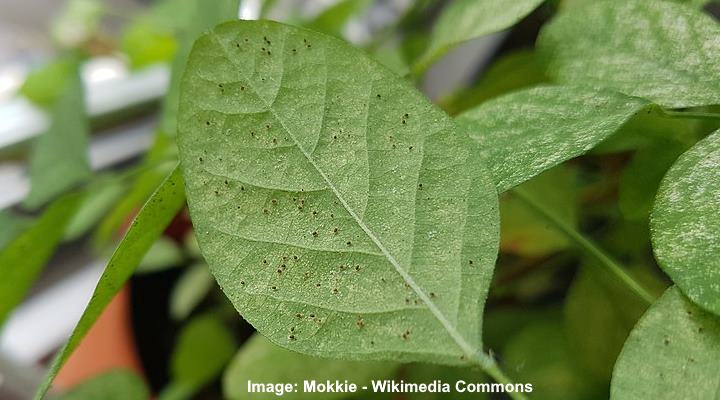
Brown spider mites found under the leaves of a plant
Brown spider mites are tiny bugs in the class Arachnida. The minute brown arachnids have eight legs and measure less than 0.04” (1 mm) long. The tiny bugs typically have a dark brown, oval body and amber-colored legs. Typically, the only sign of spider mites is webbing and silky strands under plant leaves.
There are several species of brown spider mites. However, spider mites can be red, and there are also species of white spider mite houseplant bugs.
Brown spider mite damage looks like small yellow or brownish patches on plant leaves. However, heavily infested plants may develop completely yellow leaves and suffer from slow growth.
Small Brown Bug Identification: Brown spider mites look like tiny speckles on the underside of trees, shrubs, and plant leaves. You may also identify them by silky webs on stems and leaves.
How to get rid of brown spider mites
The best way to eliminate a brown spider mite infestation is to use a forceful jet of water to blast spider mites off the leaves. However, you should target the underside of leaves as that is where the tiny brown mites live.
Spider mites thrive in hot, dry conditions and are attracted to stressed plants. Therefore, keep shrubs and plants in your garden well-hydrated during arid summers by providing at least 1” (2.5 cm) of water weekly and adding mulch around the root area.
Brown Asiatic Garden Beetles (Maladera castanea)
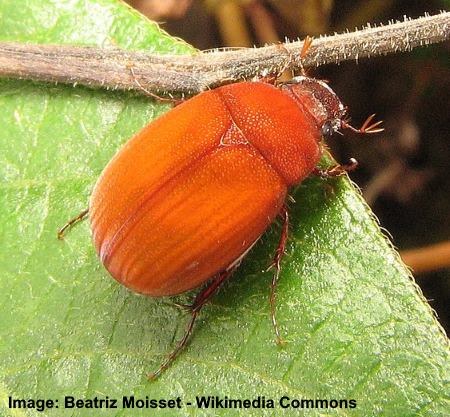
The brown Asiatic garden beetle feeds at night and is active in the summer
The Asiatic garden beetle is a cinnamon-brown beetle that looks like a roasted coffee bean. The brown, pesky bugs measure 0.375” (9.5 mm) long and have an oblong-oval body with faint ribbing on their backs. Asiatic garden beetles are common throughout North America from June until October.
Asiatic garden beetles can be tricky to spot because their chestnut-brown color makes them blend with soil, mulch, and garden debris. Additionally, they feed at night, so there is little chance you’ll spot them during the day. Finally, they are attracted to lights in the evening, so the brown bugs can also become a pest in the home.
Asiatic garden beetle damage can be extensive as they eat leaves of many flowers like asters, chrysanthemums, geraniums, and roses, giving the foliage a ragged appearance. However, the plant-destroying bugs will also defoliate many other plants in your yard, including turfgrass.
Small Brown Bug Identification: The small Asiatic garden beetle is identified by its reddish-brown color and oval body.
How to get rid of brown Asiatic garden beetles
The best way to eradicate Asiatic garden beetles is to handpick them. You can do this by laying out white sheets under infected trees. Then once it’s dark, shake the tree or shrub foliage, so the beetles drop on the sheets. Afterward, gather them up and drop them in a hot, soapy water bucket.
Brown Marmorated Stink Bug (Halyomorpha halys)
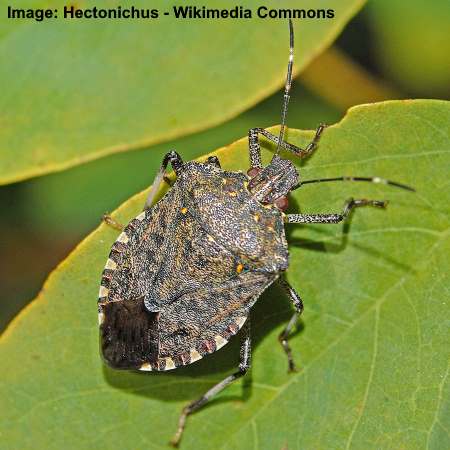
The brown marmorated stink bugs can be identified by their shield-shape body with mottled brown patterns
The brown marmorated stink bug is an invasive pest, easily identifiable by its dark brown body in the shape of a shield. The brown stink bug measures 0.75” (19 mm) and has mottled brown patterns on its body. Additionally, the stink bugs have white bands on their brown legs.
Brown marmorated stink bug damage results in deformed fruit, vegetables, and leaves, making crops unsaleable. Although the brown bugs are harmless to humans, they can get into homes and cause a foul stench when crushed.
Small Brown Bug Identification: Brown stink bugs are easy to identify due to the distinctive shield-shaped brown body with marble-like patterns and a triangular patch at their tail end.
How to get rid of brown marmorated stink bugs
Eradicating brown stink bugs from gardens is challenging. You can try placing row covers over crops or regularly checking leaves for eggs. To keep stink bugs out of your house, caulk cracks and openings around window and door frames and where pipes enter buildings.
Squash Bugs (Anasa tristis)
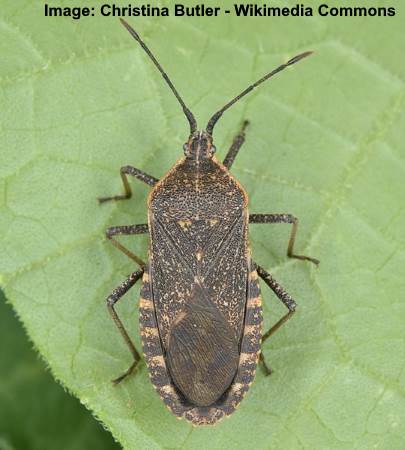
Squash bugs have a flattened brown body and are destructive pests in gardens if you grow squash family plants
Squash bugs are oval-shaped bugs with a flattened body, long antennae, and a dark gray to dark brown color. Squash bugs are relatively large and measure 0.6” (15 mm) long. On their flat brown back, you will notice a dark V or U-shaped patch with the apex pointing to the head.
Squash bug damage usually occurs on plants in the gourd or squash family Cucurbita. Therefore, these pesky brown bugs will typically attack pumpkins, cucumbers, zucchini, and watermelon. In addition, squash bug damage usually is on tender plants and seedlings.
Small Brown Bug Identification: Squash bugs are identified by their brown flat-backed body, brown legs, and two brown antennae. Squash bug nymphs have a tear-shaped body and are grayish-white color with black legs.
How to get rid of squash bugs
If you grow plants from the squash family, early detection of the bugs is crucial. Check tender plants daily, handpick the bugs, and then drop them into soapy water. Also, look for clusters of bronze-colored eggs on the underside of leaves.
Colorado Potato Beetle (Leptinotarsa decemlineata)
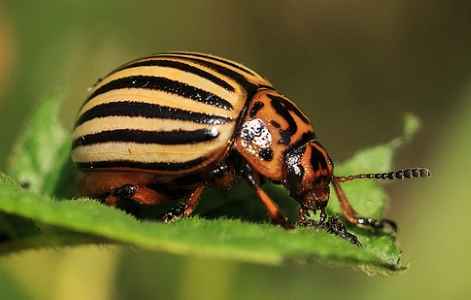
The Colorado potato beetle is identified by its orange head and black markings as well as beige-light brown striped body
The Colorado potato beetle has a distinctive pale brown-beige striped oval, rounded body. Also called the ten-lined potato beetle, the highly destructive insect measures 0.24” to 0.43” (6 – 11 mm) long. The orange-light brown bugs are recognized by their five bold black stripes on each wing cover.
Colorado potato beetle damage on potato crops can be extensive. The striped, orange-pale brown bugs can defoliate potato plants and cause destruction to tomato leaves and eggplant crops. In some cases, a large infestation can destroy an entire crop.
Small Brown Bug Identification: The Colorado potato beetle is easy to recognize due to its beige and black stripes, flattened orange head with black dots, and two segmented antennae.
How to get rid of the Colorado potato beetle
Several nontoxic pest control methods can help to control Colorado potato beetle populations. For example, certain strains of Bacillus thuringiensis can kill larvae if you treat the soil in early spring. Also, a pathogenic fungus called Beauveria bassiana can be effective in killing Colorado potato beetles.
In addition, if you plant potatoes, it’s good to practice crop rotation to help prevent beetle populations building up early in the season.
Related articles:
- Small Black Bugs on Plants – Identification Guide
- Green Bugs on Plants – Control and Identification Guide
- White Bugs on Plants (With Pictures)
